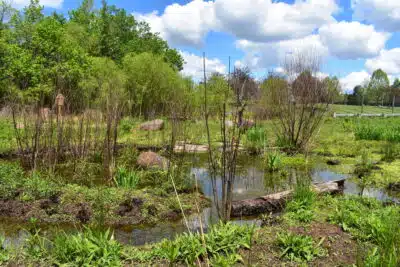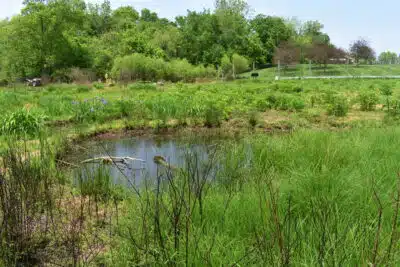If you’ve ever visited our wet meadow in the Grange village, you may have noticed some small pools of water, they’re called vernal pools. A vernal pool is a seasonal pool of water that provides habitat for distinct plant and animal species. They are a unique type of wetland, as they are usually not connected to other wetlands or water sources and generally dry out at some point in the year. Because they don’t have permanent inlets or outlets, they rely almost solely on rainfall or snowmelt!

Although you may look at vernal pools and think “That’s just a puddle”, it is quite the contrary. Vernal pools are essential for maintaining health and biodiversity in our forests and meadows. Even though they can be small, they have many important jobs. They provide food and water for a variety of species like turtles, birds, deer, racoons, squirrels, snakes, hawks, and other wildlife. While some animals just stop by for a quick sip of water, others take advantage of the vernal pools’ lack of certain predators, like fish, and use the pools as habitat for breeding and egg storage. For example, vernal pools are a prime location for wood frogs to lay their eggs to avoid the threat of predation by animals that frequent streams or rivers.
Vernal pools also provide temporary habitat for many species like salamanders, frogs, insects, and in certain regions tiny crustaceans. The pools are ideal for many amphibians, and as the spring temperatures begin to rise and bring rain, they find temporary shelter in the pools while they travel to other destinations.
Another benefit of vernal pools is they slow floodwaters in times of heavy rain. They are able to do this because of their capacity to hold large amounts of water. Because of this ability, they also help improve the flood resistance of an area.

Unfortunately, vernal pools are disappearing. In California, about 90% of their vernal pools have been destroyed due to climate change, fragmentation, changes in water chemistry, and spread of invasive species. The loss of vernal pools can have shattering effects on the surrounding ecosystems. Local extinctions can occur, as many species rely on vernal pools to complete their life cycles, which dramatically decrease biodiversity and create a ripple effect in the food chain. The amphibians that live in vernal pools help manage insect populations and are also reliable prey for larger animals. Each organism has a role in the food chain in order to keep a balanced ecosystem. When there is a disruption in the food chain, food availability for many organisms can become scarce which affects us too! That’s why it’s important to protect vernal pools by keeping vegetation in and along the edges of wetlands and vernal pools, preventing invasive species from invading, as well as not spraying any chemicals into or around the pools. But most importantly, educating others on the importance of vernal pools! Next time you stumble upon a vernal pool, look around the edges and into the water, what wildlife can you find?
Written by Willowsford Conservancy Ranger, Emily Lawrence
Learn more:
Vernal Pools – PNHP Best Management Practices.pdf (state.pa.us)
Vernal Pools: Ephemeral Ecologies | The Common Naturalist
Wetland Types | Department of Environmental Conservation (vermont.gov)
